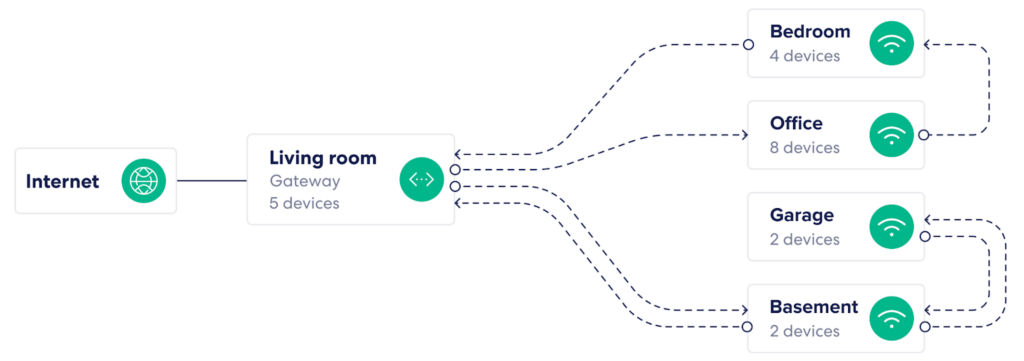
At eero, innovation is at the core of everything we do—we’re constantly introducing new features and capabilities to improve our customers’ internet experience, like eero Internet Backup and eero Built-in to deliver increased coverage, faster speeds, and even more reliability. We’re excited to announce that our recently released eero OS v6.14.0 (which nearly all customers have already been upgraded to) included a major update to our patented TrueMesh technology. With this update, eero Pro 6E and eero Pro 6 owners running multiple connected devices (like laptops, smart home devices, etc.) on their network could see up to a 50% increase in throughput and up to a 20% reduction in network/mesh latency.1 This improvement was rolled out through our automatic software updates, so customers don’t have to lift a finger.
What is TrueMesh?
TrueMesh is our patented mesh networking technology. With TrueMesh, eero devices connect wirelessly to every other eero device within range of your network, on the 2.4Ghz, 5Ghz, and, for eero Pro 6E, the 6GHz wifi bands. This creates a network of connections that give an eero network redundant links and the opportunity to redirect to the ideal path.
TrueMesh technology dynamically finds the ideal path for data to pass through a network, limiting interference and helping ensure our customers have a fast, reliable internet experience. TrueMesh does this by automatically choosing the fastest path for network traffic based on a variety of factors like a network’s layout, interference from neighboring networks, and connected devices.

So, when there’s wireless interference from the neighbor’s baby monitor, thick walls, or heavy gaming traffic in the family room, TrueMesh dynamically finds the ideal route to pass data through a network. By quickly switching paths to minimize interference, the network is less likely to come to a crawl.
TrueMesh enhancements
We’re constantly pursuing new ways to make our customers’ experience better, which led us to rethinking TrueMesh. We made our TrueMesh technology even smarter and more efficient, because networks have grown busier with more connected devices that make traffic patterns complicated and constantly changing. With this update, TrueMesh now actively evaluates each connected device’s connection to the network (and available uplink bands) and picks the ideal mesh backhaul radio band dynamically per connected device to optimize performance. Based on these factors, network traffic is directed using the optimal band for each device individually rather than sending mesh traffic from all network devices through the same channel simultaneously.
While our original TrueMesh looked at the links between a customer’s eero devices to decide where to send all network traffic, our latest improvements allow TrueMesh the ability to evaluate the links between all of the connected devices and eero devices on a network. This helps spread network traffic more evenly across the mesh links in a network, resulting in up to a 50% increase in throughput and a lower network/mesh latency of up to 20%.1
Availability
These TrueMesh enhancements are available to eero Pro 6E and eero Pro 6 customers now through an automatic software update and will potentially expand to other eero devices going forward. To make sure you’re on the latest firmware (eero OS v6.14.0 and above), go to the eero app, tap Settings, and then Software version to see if a Software Update is available.
We’re always looking for ways to make our customer’s connectivity experience even better through updates like this. To learn more about TrueMesh, click here.
1Assumes at least a 1 Gbps internet connection and a multi-eero network topology—performance benefits are assessed at the extender only. Performance testing included a range of clients (1-10) connected to an eero Pro 6E / eero Pro 6 running eeroOS versions with and without this new functionality enabled. Actual results will vary based on factors such as internet speed, interference, number of connected devices, device usage, building materials, and obstructions.

You must be logged in to post a comment.